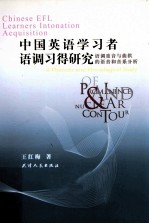

中国英语学习者语调习得研究 语调重音与曲拱的语音和音系分析PDF电子书下载
- 电子书积分:11 积分如何计算积分?
- 作 者:王红梅著
- 出 版 社:天津:天津人民出版社
- 出版年份:2008
- ISBN:9787201059971
- 页数:278 页
Chapter One Introduction 1
1.1 Research background 1
1.2 Purpose of the study 5
1.3 Significance of the study 7
1.4 Organization 9
Chapter Two Literature Review 11
2.1 Approaches to English intonation 12
2.1.1 The British configurational approach 12
2.1.2 The American level approach 14
2.1.3 The IPO approach 15
2.1.4 The AM approach 16
2.1.4.1 Fundamental principle of the AM approach 16
2.1.4.2 Stress analysis in the AM approach 19
2.2 English prominence distribution rule 22
2.2.1 Content words and function words 22
2.2.2 Nuclear stress rule(NSR)by Chomsky and Halle(1968) 23
2.3 Intonation characteristics of English and Chinese 26
2.3.1 Intonation characteristics of English 26
2.3.1.1 Vowel compression and truncation 26
2.3.1.2 Prominence grid 27
2.3.1.3 Tendency toward isochrony 29
2.3.2 Characteristics of Chinese intonation 30
2.3.2.1 Tones in Chinese 30
2.3.2.2 Syllable-timed language 31
2.3.2.3 Sentence intonation and word tonal contour interaction 32
2.3.2.4 Pitch range variation 33
2.3.3 Problems in intonation acquisition for Chinese learners 33
2.4 OT and Learnability 35
2.4.1 OT basics 35
2.4.2 Intonation in OT 38
2.4.3 Learnabilitv issue in OT 39
2.5 Relevant studies on English intonation acquisition 41
2.5.1 Previous researches on English intonation in SLA 41
2.5.2 Previous researches on Chinese learners 45
2.6 Summary 50
Chapter Three Research Design 52
3.1 Research questions 52
3.2 Subjects 54
3.2.1 Chinese learners of English 54
3.2.2 British speakers 55
3.3 Reading material and experiment sentences 56
3.3.1 Reading material 56
3.3.2 Experiment sentences 57
3.4 Read speech corpus 58
3.4.1 Selection of the native speakers'recordings 58
3.4.2 Recordings of Chinese learners 59
3.5 Scoring and group division 60
3.5.1 Scoring and correlation among the six scorers 60
3.5.2 Group division 62
3.6 Labeling the recorded material 64
3.6.1 Labeling instrument 64
3.6.2 Labeling system 65
3.6.3 Labeling procedure 71
3.6.4 Prominence identification 73
3.6.4.1 Pitch accent identification 74
3.6.4.2 Intensity and duration identification 75
3.6.4.3 Semantic cues in prominence identification 76
Chapter Four Prominence Analysis and Discussion 79
4.1 Introduction 79
4.2 Prominence in declarative sentence 80
4.2.1 The British speakers 80
4.2.2 The high group of Chinese learners 82
4.2.3 The low group of Chinese learners 84
4.2.4 Comparative analysis 86
4.3 Prominence in exclamatory sentence 90
4.3.1 The British speakers 90
4.3.2 The high group of Chinese learners 92
4.3.3 The low group of Chinese learners 93
4.3.4 Comparative analysis 94
4.4 Prominence in imperative sentence 97
4.4.1 The British speaker 97
4.4.2 The high group of Chinese learners 98
4.4.3 The low group of Chinese learners 100
4.4.4 Comparative analysis 101
4.5 Prominence in tag question 103
4.5.1 The British speakers 104
4.5.2 The high group of Chinese learners 105
4.5.3 The low group of Chinese learners 106
4.5.4 Comparative analysis 108
4.6 Prominence in yes/no question 111
4.6.1 The British speakers 111
4.6.2 The high group of Chinese learners 113
4.6.3 The low group of Chinese learners 114
4.6.4 Comparative analysis 115
4.7 Prominence in wh-question 119
4.7.1 The British speakers 119
4.7.2 The high group of Chinese learners 120
4.7.3 The low group of Chinese learners 121
4.7.4 Comparative analysis 123
4.8 Prominence in declarative question 126
4.8.1 The British speakers 126
4.8.2 The high group of Chinese learners 128
4.8.3 The low group of Chinese learners 129
4.8.4 Comparative analysis 130
4.9 Discussion 133
4.9.1 Number of stressed words 133
4.9.2 Shared prominence patterns 135
4.9.3 Distinctive prominence patterns 136
4.9.4 Fitness test between the learners and the NS 138
4.10 Summary 141
Chapter Five Nuclear Contour Pattern Analysis 143
5.1 Introduction 143
5.2 Nuclear contour in declarative sentence 145
5.3 Nuclear contour in exclamatory sentence 147
5.4 Nuclear contour in imperative sentence 149
5.5 Nuclear contour in tag-question 151
5.6 Nuclear contour in yes/no-question 153
5.7 Nuclear contour in wh-question 155
5.8 Nuclear contour in declarative question 157
5.9 Discussion 159
5.9.1 Universals about English nuclear contour patterns 159
5.9.2 Nuclear contour patterns for the NS 162
5.9.3 Nuclear contour patterns for the Chinese learners 167
5.9.3.1 Chi-square test of the nuclear contour patterns 168
5.9.3.2 Recoded nuclear contour patterns 170
5.10 Summary 174
Chapter Six An OT Diagnosis 175
6.1 Introduction 175
6.2 An OT diagnosis on prominence distribution patterning 176
6.2.1 Prominence distribution patterning for the NS 176
6.2.1.1 Prominence constraint ranking for the NS 176
6.2.1.2 OT diagnosis on seven sentences 178
6.2.2 Prominence distribution patterning for the Chinese learners 189
6.2.2.1 Prominence constraint ranking for the Chinese learners 189
6.2.2.2 OT diagnosis on seven sentences 190
6.3 An OT diagnosis on nuclear contour structure 210
6.3.1 Nuclear contour finite-state grammar 210
6.3.2 The OT analysis of nuclear contour structure 211
6.4 Summary 214
Chapter Seven Conclusions 215
7.1 Major findings 215
7.2 Contributions 218
7.3 Implications 220
7.4 Limitations and further studies 223
Bibliography 225
Appendix A Reading passage 246
Appendix B Scores for the HG and the LG 249
Appendix C Speech spectrum of the NS samples 251
Appendix D Speech spectrum of the learner samples 255
Appendix E Prominence fitness in read speech 262
Appendix F Nuclear contour Chi-square test in read speech 265
- 《党员干部理论学习培训教材 理论热点问题党员干部学习辅导》(中国)胡磊 2018
- 《深度学习与飞桨PaddlePaddle Fluid实战》于祥 2019
- 《全国普通高等中医药院校药学类专业“十三五”规划教材 第二轮规划教材 有机化学学习指导 第2版》赵骏 2018
- 《基于核心素养的有效学习与学业评价策略 初中政治》李亚莉主编 2018
- 《《经典释文》的特殊读音与普通话语音规范》陈会兵著 2019
- 《人体寄生虫学学习指导与习题集 供基础 临床 预防 口腔医学类专业用 第2版》诸欣平,苏川 2018
- 《大学信息技术基础学习与实验指导教程》安世虎主编 2019
- 《牛津中国心理学手册 上 认知与学习》(美)迈克尔·哈里斯·邦德主编;赵俊华,张春妹译 2019
- 《基于核心素养的有效学习与学业评价策略 初中英语》高婉妮主编 2018
- 《普通化学学习指导》王春娜,石军,贾临芳主编 2014
- 《办好人民满意的教育 全国教育满意度调查报告》(中国)中国教育科学研究院 2019
- 《人民院士》吴娜著 2019
- 《中国人民的心》杨朔著;夕琳编 2019
- 《中华人民共和国成立70周年优秀文学作品精选 短篇小说卷 上 全2册》贺邵俊主编 2019
- 《中华人民共和国成立70周年优秀文学作品精选 中篇小说卷 下 全3册》洪治纲主编 2019
- 《中华人民共和国药典中成药薄层色谱彩色图集》(中国)国家药典委员会 2019
- 《北京人民艺术剧院剧本系列 白露》刘国华,马鹏程 2019
- 《中华人民共和国成立70周年优秀文学作品精选 中篇小说卷 上 全3册》洪治纲主编 2019
- 《中华人民共和国国歌 钢琴谱》聂耳编 2019
- 《中国人民大学研究报告系列 中国水处理行业可持续发展战略研究报告 膜工业卷 3》(中国)郑祥,魏源送,王志伟 2019
